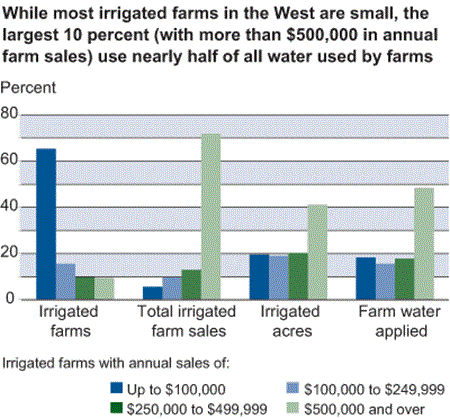Irrigation, Water Conservation, and Farm Size in the Western United States

Irrigation is critical to U.S. agriculture. While just 16 percent of all harvested cropland is irrigated, this acreage generates nearly half the value of all crops sold. Agriculture accounts for over 80 percent of water consumed in the U.S. Because of its large share of total consumption, agriculture is central to the challenge of balancing water demands among alternative uses, including increasing water demand for urban, industrial, and environmental uses.
Irrigation is particularly important for agriculture in the 17 Western States—even though only 30 percent of the harvested cropland on all farms in the West is irrigated. On irrigated farms in the region, irrigation is used on over 80 percent of harvested cropland. Irrigation systems are split evenly between gravity-based (such as flooding furrows or entire fields) and more efficient pressure systems (such as center-pivot sprinklers). Key to improving irrigation efficiency are Federal, State, and local cost-share programs that address farm water delivery systems (such as the lining of open-ditch systems) and/or the adoption of more efficient technologies (such as low-pressure sprinkler systems). About 13 percent of irrigated farms in the West participated in public cost-share programs for irrigation or drainage conservation improvements between 1994 and 1998.
These cost-share programs could be more effective if more carefully targeted. Most irrigated farms are small (less than $250,000 in annual farm sales), as are most farms that receive cost-share payments to improve irrigation efficiency. But larger farms are by far the heaviest users of irrigation water; the largest 10 percent of irrigated farms in the West account for half of total farm water applied. Cost-share programs that target larger farms would likely conserve more water, making more water available to meet environmental and other objectives, especially when integrated with water markets, water banks, and conserved-water-rights programs. Water banks and conserved-water-rights programs are relatively new State water management programs that either “bank” conserved agricultural water for future use, usually in a reservoir, or share conserved water among alternative water-use interests.
A new ERS database on irrigation systems and the characteristics of irrigated farms in the 17 Western States is a first step in understanding the impact of cost-share programs. It is based on data from USDA’s 1998 Farm and Ranch Irrigation Survey.
Irrigated Agriculture in the United States, USDA, Economic Research Service, August 2019
Irrigation & Water Use, by Aaron Hrozencik, USDA, Economic Research Service, September 2023


